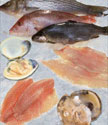
 |
Algae form the base of our food web and thus can have widespread impact. Some organisms act as transporters (also known as "vectors") for the algal-derived toxins but are unaffected themselves. In many cases the toxins can be transported through the food web to humans. Depending on the toxin's potency, it may cause mild symptoms or death. In non-toxic HABs, the food web may still be impacted because of environmental changes; examples include "Brown Tides" and "Fish Kills." |
|
TOXIC DINOFLAGELLATE BLOOMS
|
|
The
dinoflagellate Gambierdiscus toxicus, which lives on
coral and seaweed, is eaten by reef fish; these reef fish are eaten
by carnivorous fish which are eaten by humans.
|
|
Certain dinoflagellates are concentrated by filter-feeding
shellfish which are eaten by humans.
|
|
Karenia brevis is eaten by fish and concentrated
by filter-feeding shellfish. Contaminated fish are eaten by birds,
dolphins, and humans; humans also eat the
shellfish. Manatees are affected by eating toxic tunicates (e.g.,
sea squirts).
|
|
Certain dinoflagellates are concentrated by shellfish
and eaten by fish and invertebrates. Seals and fish are affected
by consuming contaminated fish. Humans
and birds are poisoned by the toxic shellfish.
|

|
TOXIC DIATOM BLOOMS
|
|
Certain diatoms are concentrated by filter-feeding shellfish
and eaten by fish and invertebrates; these organisms are eaten by
birds and humans. Sea lions are affected
by consuming contaminated fish.
|
 |
|
In mid-Atlantic waters, the presence of Aureococcus anophagefferens causes larval fish,
shellfish and copepods to stop feeding and starve to death. In
Texas, the eggs of fish such as the Red Drum (shown at right)
will not hatch during massive Aureoumbra lagunensis blooms. Some scientists
attribute these organisms' reactions to a "sugary coating"
which is produced by the phytoplankton. During massive blooms, sunlight
is blocked and seagrasses die in the murky, brown waters.
|
|
 |